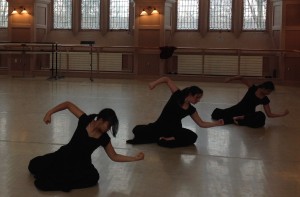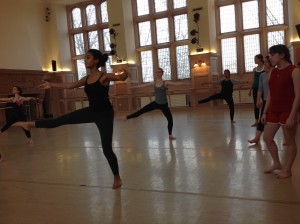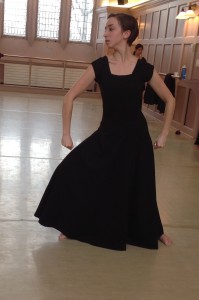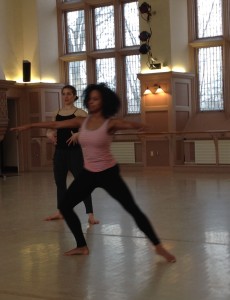In her autobiography, Blood Memory, Martha Graham wrote:
In those early days a favorite of mine, the critic Stark Young, said to a friend, ‘Must I join you at Martha’s dance concert tonight? All that percussive angular movement—I am so afraid she’ll give birth to a cube.”
It’s true that the shapes made through Graham’s choreography are not the demurely graceful ones of classical ballet and the quality of movement created by her early technique is not classically feminine – that is, silken and smooth – either.
 During those first few weekends of rehearsals with Jennifer Conley, she spoke to the dancers about “shaping the space” with their bodies. This would be done through a focus on equal and opposite forces. I now know this to be an integral part of Graham technique, which involves isometric exercises designed to highlight and enhance the strength and power of the physical body.
During those first few weekends of rehearsals with Jennifer Conley, she spoke to the dancers about “shaping the space” with their bodies. This would be done through a focus on equal and opposite forces. I now know this to be an integral part of Graham technique, which involves isometric exercises designed to highlight and enhance the strength and power of the physical body.
I had no experience with Graham technique – and very limited experience with modern dance in general – before becoming involved with this project. Though I knew, conceptually, who Martha Graham was and what modern dance looked like, I had zero kinesthetic knowledge of this dance form. Therefore, to inform my documentation of Mawr Steps (and for my own edification and enjoyment!) I took part in the warm ups that Jennifer began each rehearsal with. These consisted of standard Graham technique floor work interspersed with exercises tailored more specifically to the choreography of Steps in the Street. I also took an Advanced Modern class during the first half of the semester, in which Carrie Ellmore-Tallitsch was teaching Graham technique.
What did I learn about Graham technique through these experiences? The complexity of simple movement! Made so by those equal and opposite forces I mentioned earlier. Martha Graham developed her technique around the relationship between breath and emotion, which is embodied in her method of contraction and release. Breathing in is a release and breathing out, a contraction.
Articulation is through the torso in this language. The pelvis and the head must be the heaviest body parts – they work in opposition to open space and drive the movement.

The dancers in Carrie’s class practice balancing/shifting weight while maintaining still, upright torsos
Graham wrote, in Blood Memory, of her first days in New York:
I walked to the Central Park Zoo and sat on a bench across from a lion in its cage…Finally, I learned to walk that way. I learned from the lion the inevitability of return, the shifting of one’s body.
In Jennifer’s words: “The goal of the contraction is expansion.” I found this prompt to be most important to the articulation of emotion and most challenging to physically accomplish.
There is more information about Martha Graham’s technique and the history of modern dance on the resources page of this blog as well as on the Graham Company website. Briefly, however, my experience of the Graham contraction after my first several days warming up with Jennifer and the dancers:
When the dancers begin moving across the floor I gracefully remove myself from the herd to watch in awe and surreptitiously practice my contracting and releasing while taking notes. Dancers, if you’ve noticed my observer’s look turn into one of consternation it is only because I am attempting to: engage new-found pelvic muscles, “scoop out” my abdomen AND effectively contract my sternum (what? yes.) without bringing my shoulders up to my ears. All of which I’m doing on an exhale, trying 1 – not to hold my breath and 2 – to actively expand my torso, opening up space between my vertebrae.


